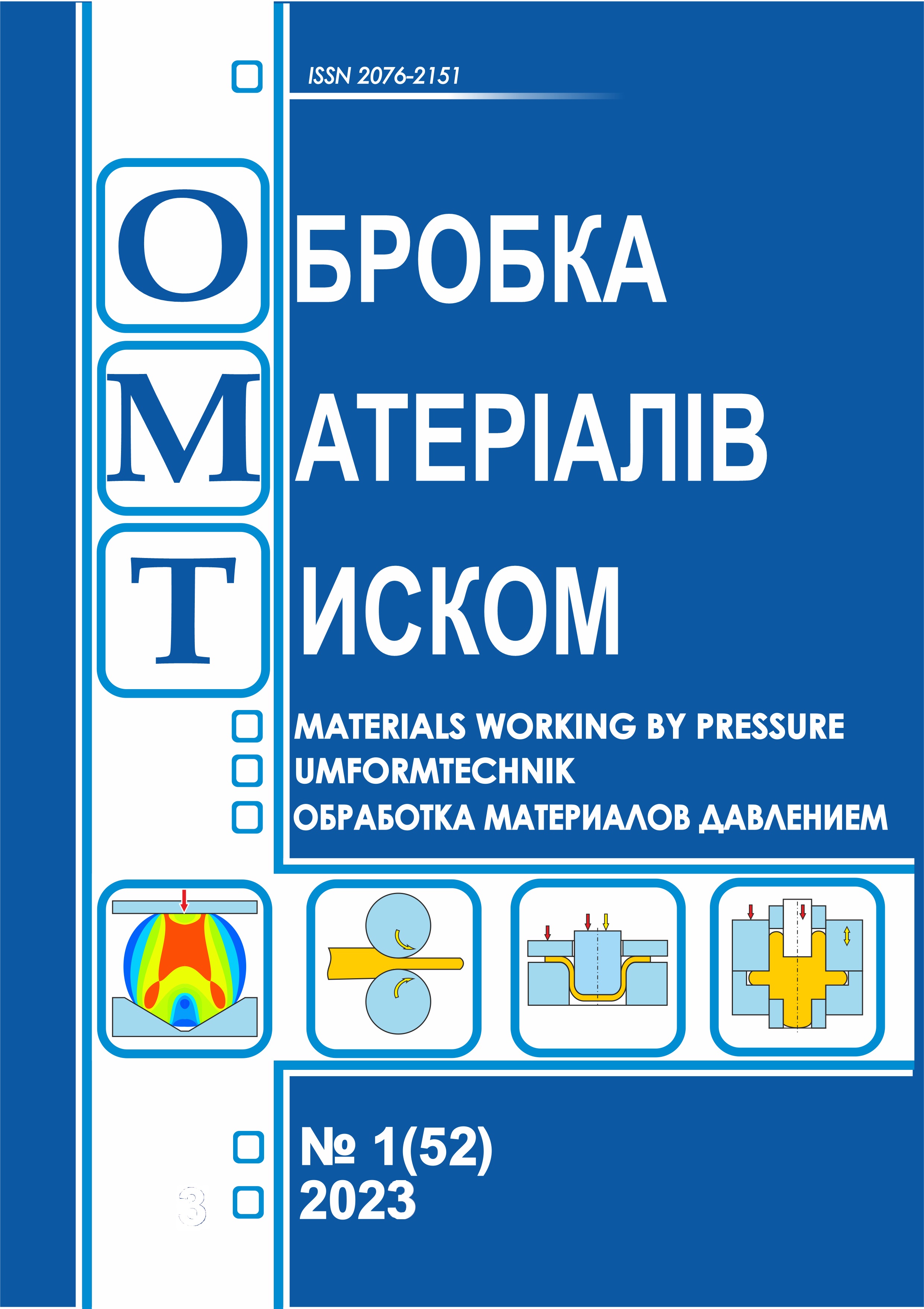Increasing extrusion tool life through combined recovery technology
DOI:
https://doi.org/10.37142/2076-2151/2023-1(52)197Keywords:
extrusion tool, aluminizing, surfacing, heat resistance, self-shielded flux-cored wire.Abstract
Grin O., Trembach I., Zharikov S. Increasing extrusion tool life through combined recovery technology.
The analysis of literature data showed that heat-resistant steels of Cr-W-Mo alloy systems with carbide strengthening (3Х3М3Ф, 30Х2В8Ф, 40Х12В4К2Ф) and steel with intermetallic strengthening (03Н15К9М5ТЮ, 04Н18М4К11, 10Х9К3В2МФБР) are used to recovery the press tool. Under the influence of variable temperature-cyclic influence in the surface layer of the deposited metal with carbide strengthening, martensite disintegration and coagulation of carbides occur, which reduces hardness and, accordingly, accelerates wear. Steels with intermetallic strengthening are promising in terms of their properties, but at the same time, the scarcity and high cost of the main alloying elements limits their use. Therefore, the development of economically alloyed steel and press tool recovery technology is an urgent issue. It was established that the maximum temperature of the surface of the punch reaches 650-750 °C with the established mode of operation and the stressed state. Analysis of the operation of press tools showed that the material for their manufacture must meet a set of requirements: high strength (at least 1000 MPa), high heat resistance, sufficient viscosity, high resistance to thermal fatigue (heat resistance), good scale resistance and high hardenability. In order to increase the reliability and durability of the press tool for deformation of copper-based alloys, a combined recovery technology is proposed, which consists in surfacing the metal on a pre-alloyed surface. When combining the technologies of chemical and thermal treatment (aluminizing) and surfacing using self-shielded flux-cored wire, the surfacing metal is saturated with aluminum and its compounds as a result of the dissolution of aluminum-rich phases in it, which contributes to the reduction of scale formation and should ensure high heat resistance of the surfacing layer.
References
Gogaev K. O., Sydorchuk O. M., Radchenko O. K. Tool stamping steels for hot deformation. Metallurgy and metal processing. 2016, 3, pp. 18–21. (in Ukranian).
Sydorchuk O. M. Properties of stamping steel 4Х4Н5М4Ф2 for hot deformation of non-ferrous metals and alloys. Bulletin of the Vinnytsia Polytechnic Institute. 2021, 1, pp. 108–111. (in Ukranian).
Grin O. G., Presnyakov V. A., Boyko I. A., Volkov S. M. Analysis of the causes of wear of working bushings when pressing workpieces from copper-nickel alloys. World of technology and technology. 2013. 3, pp. 34–37. (in Russian).
Aliyev I. S., Aliyeva L. I., Lobanov A. I., Savchinsky I. G. Ensuring the durability of stamping equipment. Metal processing. 2007, 5, pp. 22–28. (in Russian).
Karpenko V. M., Koshovyi O. D., Katrenko V. T. Optimization of the composition of deposited metal for a press tool. In the book: Theoretical and technological foundations of surfacing. Surfacing of parts and equipment of metallurgy and energy. Kyiv, IEW named E.O. Paton, Academy of Sciences of the Ukrainian SSR. 1980, pp. 42–48. (in Russian).
Karpenko V.M., Koshovyi A.D., Gavrilov A.V. Increasing the stability of a press tool by means of mechanized surfacing with self-protecting flux-cored wire. In Sat.: Ways of increasing the efficiency of welding production and improving the quality of welded structures. Minsk. 1978, pp. 64–65 (in Russian).
Barmin L. M., Korolev N. V., Pryakhin A. V. Properties of martensitic aging alloys for surfacing of hot and cold deformation tools. In the book: Theoretical and technological foundations of surfacing. Properties and tests of deposited metal. Kyiv; type of IEW named E. O. Paton, Academy of Sciences of the Ukrainian SSR. 1979, pp. 55–61. (in Russian).
Gryn O. G., Zharikov S. V., Dudynskyi A. D. A method of increasing the durability of stitching stamps. Welding and related technologies, development prospects. Materials of the 4th international scientific and technical conference. October 4-7, 2016: In general ed. Dr. Tech. Sciences N. O. Makarenko. Kramatorsk: DDMA. 2016. 140 p. (in Russian).
Tyshaev S. I. New steel 5Kh2VMNF (Dn-32) for hot deformation stamping tools. Forging and stamping production. 1973. 6, pp. 14–18. (in Russian).
Frumin I. I. Modern types of deposited metal and its classification. Theoretical and technological foundations of surfacing. Welded metal. Ed. I. I. Frumin. Kyiv. IEW named E. O. Paton. 1977, pp. 3–11. (in Russian).
Kozlov P.A., Skorobogatykh V.N., Shchenkova I.A. Structure, mechanical properties and heat-resistant characteristics of 10Kh9K3V2MFBR and 02Kh9K3V2MFBR steels. Scientific information of BelSU. Series: Mathematics. Physics. 2011. 11, pp. 134-141. (in Russian).
Kondratiev I.A., Ryabtsev I.A., Chernyak Y.P. Powdered wire for surfacing a layer of martensitic aging steel. Automatic welding. 2006. 4, pp. 50–53 (in Russian).
Leynachuk E.I., Pidgaetskyi V.V., Parfeso G.I. The influence of chromium on the resistance of weld metal against the formation of crystallization cracks. Automatic welding. 1978. 1, pp. 20–23 (in Russian).
Zablotskyi V.K., Shimko O.I. Peculiarities of the impact of alitization on the structure and properties of steel 10. East European Journal of Advanced Technologies. Kharkiv. 2005, 6, pp. 33–36. (in Russian).
Stolbov V. O., Mogilenets M. V., Dumenko K. O., Kryvchyk L. S., Khokhlova T. S., Pinchuk V. L. Use of chemical and thermal treatment for the purpose of strengthening pipe tools for the production of stainless pipes. Metallurgical and mining industry. 2020, 4, pp. 52–71.
BARTKOWSKA Aneta, POPŁAWSKI Mikołaj, PRZESTACKI Damian. Heat and Thermochemical Treatment of Structural and Tool Steels. Journal of Research and Applications in Agricultural Engineering. 2015. Vol. 60(2). [Electronic resource] - http://www.pimr.poznan.pl/biul/2015_2_BPP.pdf

